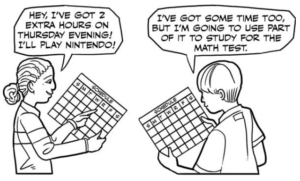Math Lab Activity
– My Weekly Schedule
Objective:
To help students organize their time effectively and make wise choices about how they spend their time during the week.
Materials Needed:
- Copy of the ‘‘My Weekly Schedule’’ worksheet (provided) for planning purposes.
- Pen/Pencil
Instructions:
Preparation:
Print the ‘My Weekly Schedule’ chart from the exercise file. (or) You can create a simple table with columns for days of the week, time slots, and activity descriptions.
Fill in Designated Activities:
Start by filling in the chart spaces for the upcoming week with activities that have specific times. These could include school hours, extracurricular activities, meal times, study sessions, and any other commitments.
Pencil in Desired Activities:
For the time slots that are not already filled, use a pencil to add activities you would like to do or accomplish during those periods. These could include hobbies, reading, exercise, spending time with family/friends, or pursuing personal interests.
Example:
The students shown below are comparing and commenting on their personal schedules and solving the problem of when to put in a particular activity.

Analyze Wise Use of Time:
Look at your schedule critically and think about how wisely you’re using your time. Consider factors like upcoming tests, assignments, and responsibilities. For instance, if you have a test on Friday, it might not be the best idea to spend all of Thursday evening watching TV.
Reflection:
After analyzing your schedule, reflect on what you’ve learned about managing your time. Think about any adjustments you might want to make to ensure a better balance between responsibilities, leisure, and personal growth.
Remember, the goal is to create a balanced and effective schedule that accommodates your various responsibilities and interests while promoting productive use of your time.
Ignite Your Mathematical Mind:
- Can you create a weekly schedule for a week when you won’t be attending school? Afterward, compare and contrast this schedule with your usual school-week schedule. How do the activities and the way you allocate your time differ between these two scenarios?
- Could you try your hand at some long-term planning? Plan out your activities and commitments for an entire month. What insights or revelations do you think might come from planning such an extended period?